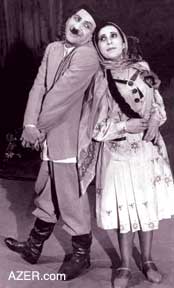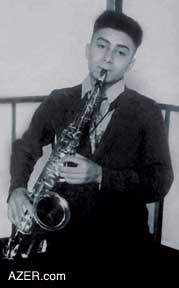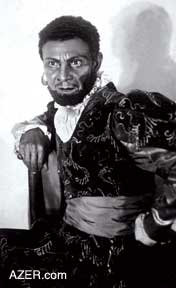|

Summer 2006
(14.2)
Pages
56-65
Politically
Correct Music
Stalin's Era and the Struggle of Azerbaijani Composers
by Aida Huseinova
  The
last century of Azerbaijan's history of music has been marked
by successful premieres and triumphal performances, but juxtaposed
against those achievements are tragic stories of torment, censorship,
and psychological pressure that many of the nation's prominent
musicians faced during the Stalinist era (1920s to 1950s). The
last century of Azerbaijan's history of music has been marked
by successful premieres and triumphal performances, but juxtaposed
against those achievements are tragic stories of torment, censorship,
and psychological pressure that many of the nation's prominent
musicians faced during the Stalinist era (1920s to 1950s).
For decades, we proudly boasted of the tremendous success of
Hajibeyov's "Koroghlu"
[Son of a Blind Man]("Koroghlu" was composed by Uzeyir
Hajibeyov and the libretto was written by Mammad Sayid Ordubadi
[1872-1950].), which made its debut in the late 1930s. We were
unaware that the opera by Uzeyir Hajibeyov (1885-1948) featuring
the theme of the masses rising up in rebellion against feudal
lords may have saved the composer's life.
Now we understand that political realities forced the composer
to manipulate this theme, reconciling it with Communist ideology
rather than follow the legendary reality of the region. (The
enemy in Hajibeyov's Koroghlu is depicted as Turks, rather than
Persians, as the legend holds forth. See "The
Other Koroghlu: Tbilisi Manuscript Sheds Light on Medieval Azerbaijani
Hero" by Dr. Farid Alakbarli. AI 10.1 (Spring 2002).
Yet the performance of Koroghlu became Azerbaijan's crowning
glory at the Decade of Azerbaijan Art in Moscow in 1938. Stalin
appeared in the audience and praised it. For Hajibeyov, it helped
to ease some of anxiety he had felt for more than two decades
when he was targeted for his "suspicious" pre-Soviet
past, especially in relationship to his own involvement (along
with his brother Jeyhun) with Azerbaijan's independence movement
which led to the establishment of the Azerbaijan Democratic Republic
(1918-1920) and with writing its National Anthem.
We used to lament the early death of the gifted jazz musician
Parviz Rustambeyov, but we never revealed that he had been arrested
for political reasons and died in prison.
Only now, after gaining independence from the Soviet Union in
late 1991, have some of these documents been found in archives,
which for so long have barred their tragic secrets from us. The
truth they reveal has shocked many of us.
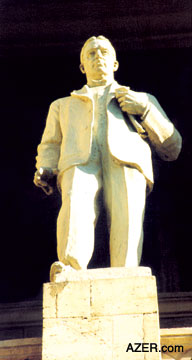  Radicalism of the 1920s Radicalism of the 1920s
"On behalf of tomorrow, let us burn Rafael, destroy the
museums and trample the flowers of art." This was one of
the major slogans of some of the radical followers of the Communist
ideology. Under the ideology referred to as Proletkult (proletarian
culture), they declared war on the cultural heritage of all Soviet
nations.
This radical attitude led to campaign attacks against two musical
phenomena in Azerbaijan. First, the apologists of Proletkult
began attacking the use of Azerbaijan's national instruments,
specifically the tar, traditional stringed instrument, which
had been used for centuries.
("Sing Tar, Sing". See the arguments related to
eliminating tar music from the diaries of Dilbar Akhundzade whose
husband Mikayil Mushfig (1908-1939) wrote the lines "Sing,
Tar Sing" in AI 10.3 (Autumn 2002). Also see "'Sing Tar,
Sing': Like Father, Like Son. Passing on the Tradition,"
by Betty Blair. AI 7.4, (Winter 1999).
Secondly, they began severely criticizing the genre of "mugham
opera"(Mugham opera is a unique hybrid genre where the general
concept obviously draws upon an opera: performers sing on stage
accompanied by a symphony orchestra, and the entire composition
is divided into several acts. However, all classical operatic
forms are replaced with mughams-traditional modal music. The
first
performance of a mugham opera took place in 1908 with "Leyli
and Majnun" by Uzeyir Hajibeyov and this work is referred
to as the "First Opera in the Muslim East".
For a short history and synopsis of the first mugham opera, see,
"Leyli
& Majnun" in AI 9.3 (Autumn 2001) (See also HAJIBEYOV.com.)
which was a synthesis of genres of West (opera) and East (Mugham
or modal music)] which had been the first example of composed
art music tradition in the country.
The first generation of national composers, notably Uzeyir Hajibeyov
(1885-1948) and Muslim Magomayev (1885-1937), were personally
attacked since their vision of the future development of Azerbaijani
music integrated tar and mugham opera as its primary components.
Had the Communists succeeded in reaching their goals by declaring
this traditional instrument and this genre a relic of the past,
and in convincing Azerbaijanis that these first national composers
were incompetent, then the development of contemporary Azerbaijani
music would today resemble a blank sheet of paper covered with
red letters of Soviet history. Fortunately, this never happened.
The campaign against tar and mugham opera was led by the Minister
of Culture Mustafa Guliyev, an arduous apologist for the Russification
of Azerbaijani music. He involved politicians, journalists, writers
and musicians in his attacks.
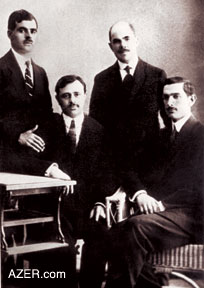  Left: Huseingulu Sarabski, Uzeyir Hajibeyov, Hanafi
Teregulov and Muslim Magomayev. Around 1913-14. Left: Huseingulu Sarabski, Uzeyir Hajibeyov, Hanafi
Teregulov and Muslim Magomayev. Around 1913-14.
Local newspapers wrote:
"We need contemporary, cultured opera to serve as a vehicle
to educate the working masses since the existing Azerbaijani
opera does not meet such criteria. What kind of relationship
can exist between a socialist culture and the Hajibeyov's musical
comedy "Arshin Mal Alan" (The premiere of "Arshin Mal
Alan" (Cloth Peddler) by Uzeyir Hajibeyov took place
in 1913.
The story line is about a wealthy
merchant desirous of seeing his merchandise before purchasing.
Specifically, it meant that he wanted, at least, to have seen
a glimpse of his future bride before deciding to marry her. In
the early 20th century in Azerbaijan, tradition required that
women be veiled. In reality, the comedy is a satire against repressive
attitudes towards women in a traditional society) written in
the times of Noah which depicts the life of wealthy merchants
and landlords?" Their biased ideology concluded that "Uzeyir
Hajibeyov and Muslim Magomayev were products of the bourgeois
world."
As for the tar, according to Minister Guliyev, it "used
to be popular at a time when it served the tastes of the elite
circles of music. The masses did not need such a sophisticated
instrument at all. As such, the tar does not - and cannot - have
a future."
Heated arguments were not confined to intel lectuals. Mugham
operas, such as Hajibeyov's "Leyli and Majnun" were
excluded from the repertoire of the Azerbaijan Opera and Ballet
Theater. Tars were publicly burned and broken. Some people were
even afraid to keep them in their homes.
Incredible struggles were going on throughout the country, opposed
by Uzeyir Hajibeyov and other Azerbaijani intellectuals, including
such composers as Asaf Zeynalli (1909-1932) was the first
Azerbaijani composer ever to get a professional music education
in Azerbaijan. He graduated from the Azerbaijan State Conservatory
(now Baku Music Academy).
Though he was very young when he died, he was extremely active
and succeeded in introducing several music genres in Azerbaijan
for the first time including the first national romance and the
first symphonic music. His "Children's Suite" paved
the way for further development of Azerbaijani music for children.
Zeynalli was also very active in transcribing Azerbaijani folk
songs) and Afrasiyab Badalbeyli(Afrasiyab Badalbeyli (1907-1976)
is best remembered for having composed "Maiden's Tower",
the first ballet in Azerbaijan (1940) who helped to defend
the cultural heritage of the nation.
Such were the first intrusions of Soviet ideology into music
matters. Fortunately, they didn't last long. The tar and mugham
opera were returned to the musical life in Azerbaijan by the
early 1930s. However, the next decade brought little hope for
optimism.
  Era of Repressions -1930s Era of Repressions -1930s
Left: Khadija Gayibova (1893-1938) with hand
on face. She was also an extremely active administrator and became
the Founder of Courses on Eastern Music (Eastern Conservatory).
She also made herself vulnerable by advocating strong ideas regarding
the further development of Azerbaijani music along an "Eastern
stream" with the establishment of an Eastern Conservatory
in the early 1920s. Such tendencies could easily be interpreted
as nationalistic, which were clearly forbidden. Gayibova was
arrested during the purges of 1937-38 and sentenced to 10 years
of hard labor. For some unknown reason, however, she was executed
in the NKVD prison.
The horror of Stalinist repression gripped the country in the
1930s, when tens of thousands of Azerbaijanis-including scientists,
writers, poets, artists, religious leaders, engineers, military
officials, government and even Communist Party officials-were
arrested.
Typically, they were ostracized from society because the government
branded them as "Enemies of the People" and threatened
anybody who befriended them with the same treatment.
"Trials" were usually carried out in the presence of
a "troika" (trio) of three representatives of NKVD
(Narodnyi Kommissariat Vnutrennikh Del-forerunner of the KGB)
and usually lasted less than 15 to 20 minutes. Rarely was there
any defense offered for the accused person. Rarely, was the accused
person even present. Hundreds of people were arrested each day,
many to be executed, exiled or sent to labor camps in Siberia.
Many died of hunger or from the severe cold climatic conditions.
Credit belongs to Farah Aliyeva for being the first musicologist
to delve into the issue of Stalin's repressions in Azerbaijani
music. (See "XX Asr Azerbaijan Musigisi - Totalitar Zaman
Kasiyinda" (20th Century Azerbaijani Music at the Crossroads
during the Totalitarian Era) in Musigi Dunyasi, No. 3-4 (17),
2003: pages 13-33.)
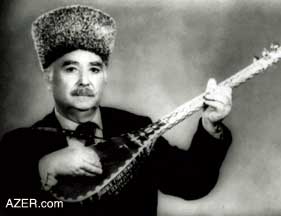 |
 |
Above: (Left) Mikayil Azafli (1924-78), one
of Azerbaijan's prominent ashugs, was arrested in 1938, at the
age of 14 for accidentally spilling ink on Stalin's portrait
during a drawing lesson at school. Azafli was immediately taken
to the NKVD. As he knew the prison layout, he was able to escape,
although later he was captured and arrested two more times -1941
and 1945-46 - for the same "crime".
(Right): Minister of Culture Mustafa Guliyev, an arduous apologist
for the Russification of Azerbaijani music involved politicians,
journalists, writers and musicians in his attacks against tar
and mugham opera. His criticism of the contemporary state of
Azerbaijani music suddenly came to be interpreted as an underestimation
of the benefits of the Socialist epoch. He was arrested in 1938
and executed shortly afterwards, sharing the fate of those whom
he had attacked earlier.
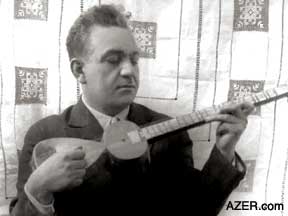  Left: Mammadkhan Bakikhanov and (Below):
Ahmad Bakikhanov, brothers who were distinguished as professional
tar players. (Ahmad was the father of composer Tofig Bakikhanov).
As the Bakikhanov family had Iranian roots, they chose to perform
Iranian mughams, which was interpreted as a sign of pro-Iranian
political orientation and their involvement in spying for Iran.
The brothers both spent nearly a year in prison and were released
only when composer Uzeyir Hajibeyov pleaded with Mir Jafar Baghirov,
head of the Communist Party in Azerbaijan, to free these these
musicians. Left: Mammadkhan Bakikhanov and (Below):
Ahmad Bakikhanov, brothers who were distinguished as professional
tar players. (Ahmad was the father of composer Tofig Bakikhanov).
As the Bakikhanov family had Iranian roots, they chose to perform
Iranian mughams, which was interpreted as a sign of pro-Iranian
political orientation and their involvement in spying for Iran.
The brothers both spent nearly a year in prison and were released
only when composer Uzeyir Hajibeyov pleaded with Mir Jafar Baghirov,
head of the Communist Party in Azerbaijan, to free these these
musicians.
Photos from the KGB
archives, which have recently been published, lay bare the horrors
of that epoch even more vividly than the texts of what transpired
during those interrogations. Despair, confusion and pain are
written across the faces of these innocent victims, exposing
the tortures and humiliation, which they suffered.
Those arrested were charged with various behaviors that were
considered to be crimes including anti-Soviet activities, pan-Turkism,
pan-Islamism, or spying for foreign intelligence services.
The true reasons why they were targeted could usually be traced
to family wealth, anti-Russian or anti-Communist activities during
the pre-Soviet era, having relatives who were living abroad;
befriending foreigners, or carrying out professional activities,
which somehow challenged communist ideology. Even the slightest
sentiment that countered
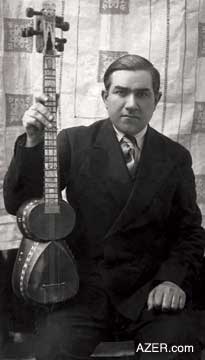  Soviet
ideology expressed privately, even through humor, could land
one in prison. Sometimes, people were vilified purely out of
personal revenge, as has come to light in regard to some of the
high-ranking officials, such as Mir Jafar Baghirov, who had been
appointed as Azerbaijan's First Secretary of the Communist Party
and served as Stalin's right hand. Soviet
ideology expressed privately, even through humor, could land
one in prison. Sometimes, people were vilified purely out of
personal revenge, as has come to light in regard to some of the
high-ranking officials, such as Mir Jafar Baghirov, who had been
appointed as Azerbaijan's First Secretary of the Communist Party
and served as Stalin's right hand.
Gallery of sadness
Almost all these criminal activities listed above could have
been used as an excuse to arrest pianist Khadija Gayibova (1893-1938).
She was also an extremely active administrator and became the
Founder of Courses on Eastern Music (Eastern Conservatory) as
well as the Music and Drama Studio for Turkic Women.
She also chaired the Department of Eastern Music of Narkompros
(Narodnyi Komissariat Prosvesheniia in Russian, which means "People's
Commissariat of Enlightenment").
Gayibova was born into the Muftizade family, members of which
held high Muslim clerical ranks. She later married Gayibzade,
the son of the Head of All Muslims of Southern Caucasus.
Her brother Mammad Muftizade was living in Turkey.
All these conditions were sufficient enough to get her arrested.
In addition, Gayibova made herself vulnerable by advocating strong
ideas regarding the further development of Azerbaijani music
along an "Eastern stream" with the establishment of
an Eastern Conservatory in the early 1920s. Such tendencies could
easily be interpreted as nationalistic, which were clearly forbidden.
As an open-minded, sociable person, Gayibova often held parties
and invited the music elite of Baku to her residence, including
Uzeyir Hajibeyov, Tarist Gurban Primov (1880-1965) and singer
Bulbul (1897-1961), as well as guest musicians, such as Reinhold
Gliere, Vladimir Gorovitz, Egon Petry and Nathan Milstein.
Musicians were not the only guests who frequented Gayibova's
home. In 1918-1920 prior to the Bolshevik takeover in Azerbaijan,
Musavat Party leaders were invited to her home, as were both
English and Turkish military officials who had come to Baku to
stave off the Russian invasion. Such associations turned out
to be fatal.
Gayibova was first arrested in 1933, but because of lack of evidence
of any criminal behavior, she was released. However, during the
repression years of 1937-1938, Gayibova was again arrested and
this time was sentenced to 10 years of hard labor. For some unknown
reason, however, she was shot in the NKVD prison. Those who shared
her prison cell said that Gayibova kept repeating in despair:
"I could have done so many things"(Gulrena Mirza, "Pervyie
zhenshiny-pianistki Azerbaijana" (Azerbaijan's first female
pianist), Azerbaijan IRS, no.4-5, 2000, 146).
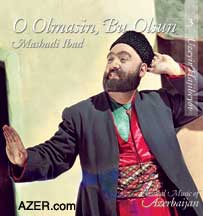  Left: Music Comedies by composer Uzeyir Hajibeyov,
such as "Mashadi Ibad" (featured here) and "Arshin
Mal Alan" (The Cloth Peddler), which were extremely popular
in the Pre-Revolutionary period (before 1920) were deemed during
the Soviet period to reflect bourgeois culture and were severely
criticized when, in fact, these works satirized many of the superficial
values and backwardness of the traditions of early 20th century
in Azerbaijan, particularly attitudes toward women, marriage,
education and religion. Left: Music Comedies by composer Uzeyir Hajibeyov,
such as "Mashadi Ibad" (featured here) and "Arshin
Mal Alan" (The Cloth Peddler), which were extremely popular
in the Pre-Revolutionary period (before 1920) were deemed during
the Soviet period to reflect bourgeois culture and were severely
criticized when, in fact, these works satirized many of the superficial
values and backwardness of the traditions of early 20th century
in Azerbaijan, particularly attitudes toward women, marriage,
education and religion.
Other musicians shared
the same fate. For example, Panfiliya Tanailidi (1892-1937),
an actress and singer who performed the major roles in some of
Hajibeyov's musical stage works, was eventually arrested for
"spying for Iran" and shot. Her tragic fate can be
traced to two situations: her close friendship with "Enemies
of the People", occasionally meeting an old friend and Iranian
citizen in Baku, and passing out Iranian cigarettes to friends
after touring there.
"Dangerous family links" was the excuse for arresting
Abbas Mirza Sharifzade (1893-1938). As Director of the Azerbaijan
Opera Theater, he staged most of the pre-Soviet Azerbaijani operas
and operettas and, indeed, played leading roles in many of them.
(Read about Sharifzade's arrest: "Reviving
the Memory of Silenced Voices: Actor Abbas Mirza Sharifzade"
by Azad Sharifov. AI 6.1 (Spring 1998).
His brother, Gulamreza Sharifzade was an active member of Musavat
Party and thus had fled Azerbaijan when the Bolsheviks came.
This was sufficient "evidence" to justify shooting
Abbas Mirza accusing him of anti-Soviet activities and spying
for Iran and Turkey.
Above: (From left to right): Singer Jahan Talishinskaya
(1909-1967) was related to a well-known scholar and Turkologist.
This association alone provided sufficient reason to not allow
her to participate at the "Decade of Azerbaijani Art and
Literature" in Moscow in 1938. She was later exiled to Kazakhstan.
Fortunately, she survived and returned to Azerbaijan after Stalin's
death in 1953.
Parviz Rustambeyov (1922-1949),
an outstanding Azerbaijani jazz musician, clarinetist and saxophonist,
was among the last innocent musicians of Stalin's terrible massacre.
Jazz music had always remained under strong suspicion during
the Soviet era.
Abbas Mirza Sharifzade (1893-1938),
Director of the Azerbaijan Opera Theater, was arrested for "dangerous
family links". He had staged most of the pre-Soviet Azerbaijani
operas and operettas and, often played the leading role. His
brother, Gulamreza Sharifzade had been an active member of Musavat
Party who organized the government during the short-lives Democratic
Republic of Azerbaijan (ADR) and thus had fled Azerbaijan when
the Bolsheviks came. This was sufficient "evidence"
to justify executing Sharifzade on charges of anti-Soviet activities
and spying for Iran and Turkey.
Singer Jahan Talishinskaya (1909-67) found herself in a similar
situation. Two family members had been accused of being "Enemies
of the People"-her sister and brother-in-law Khalid Said
Hojayev, who was a well-known scholar and Turkologist. This association
alone provided sufficient reason to pass over her and not allow
her to participate at the "Decade of Azerbaijani Art and
Literature" in Moscow in 1938. She was later exiled to Kazakhstan.
Fortunately, she survived and was able to return to Azerbaijan
after Stalin's death in 1953.
Outspokenness also sealed the fates of a number of musicians,
including Sergey Paniyev (1884-?) (According to F. Aliyeva,
the date of Paniyev's death has not been identified), who was
the Music Director of the Baku Russian Workers Theater as well
as the Chairman of the Union of Azerbaijani Composers. The KGB's
damning evidence against him included passing remarks he had
made, even about the cafeteria food: "Once we had lunch
in the canteen in Baksovet (Bakinskii Sovet, meaning Executive
Power of Baku or City Hall) with Paniyev. After mentioning the
very poor quality of the soup, Paniyev added that it seemed to
have been cooked according to the Party's program."(Farah
Aliyeva, "XX asr Azerbaijan musigisi," 20).
Another witness had testified: "In 1936, when discussing
the article in Pravda criticizing Shostakovich, (Shostakovich
was the main target for Stalin's 1948 campaign against "formalism"
in Soviet music. In fact, this was an attempt to isolate Soviet
music from the mainstream on 20th century music. Shostakovich
was dismissed from professorship at the Moscow Conservatory and
singled out. People were frightened to associate or even talk
to him). Paniyev expressed his frustration and anger, giving
rein to statements against the Party's main publishing body."
(Farah Aliyeva, "XX asr Azerbaijan musigisi," 20.)
Likewise, Mikayil Azafli (1924-78), one of Azerbaijan's prominent
ashugs, was arrested in 1938, at the age of 14 for spilling ink
accidentally on Stalin's portrait during a drawing lesson at
school. Azafli was immed12iately taken to the NKVD (Ali
Kafkasiyali in "Mikayil Azafli: Hayati, Sanati, Asarlari"
(Mikayil Azafli: Life, Career, Works) Erzurum: Eser Ofset, 1996).
As he knew the prison layout, he was able to escape, although
later he was captured and arrested two more times-1941 and 1945-46-for
the same "crime".
Playing the "wrong" type of music could also have dangerous
implications for those who dared it. The only fault of the two
distinguished Azerbaijani tar players, brothers Ahmad and Mammad
Bakikhanov, was that they chose to perform Iranian mughams. As
the Bakikhanov family had Iranian roots, this was interpreted
as a sign of pro-Iranian political orientation and, their involvement
in spying for this neighboring country. Both of these musicians
spent nearly a year in a jail and were released only when Uzeyir
Hajibeyov pleaded with Mir Jafar Baghirov to show mercy on these
outstanding musicians.
Predictably at a certain point, the repression engine began to
implode in upon itself and started to swallow its own executors.
This happened to Mustafa Guliyev, who had initiated campaigns
against the tar and mugham opera in the 1920s.
His criticism of the contemporary state of Azerbaijani music
suddenly came to be interpreted as an underestimation of the
benefits of the Socialist epoch. Arrested in 1938 and executed
shortly afterwards, Mustafa Guliyev shared the fate of those
whom he had attacked earlier.
The campaign against the "Enemies of the People" continued
until Stalin's death in 1953. Parviz Rustambeyov (1922-1949),
an outstanding Azerbaijani jazz musician, clarinetist and saxophonist,
was among the last innocent musicians of Stalin's terrible massacre.
Jazz music had always remained under strong suspicion during
the Soviet era. One of the famous Communist slogans of the Stalinist
era was: "Today, he is playing jazz; tomorrow, he will betray
the country!"
In 1944, Parviz was invited to join the orchestra of the famous
Polish jazz trumpeter Eddie Rosner (1910-1976)(Eddie Rosner
gained acclaim for his trumpet playing and ability to play two
trumpets at once. His career could have been in jeopardy as a
Jew after the invasion of Poland by the Nazis, but he fled to
the Soviet Union, which at that time embraced jazz. Hence, he
initially achieved an equally glowing reception in the USSR as
he had in France. Joseph Stalin even called to say he enjoyed
his performance for him. This led to his being made the head
of the Soviet Jazz Orchestra for a time. After the war this all
changed.
By 1946 Stalin became increasingly hostile to Jews and foreigners
and Rosner fell into disfavor and was sent to the Gulag prisons
on charges of treason with a 10-year sentence. He continued to
perform in the Gulag, however, and was allowed to use, or be
used, to lift the spirits of those interned. He was released
in 1953 after Stalin died. He returned to his native Berlin in
1973 and died there in poverty three years later [Wikipedia,
May 22, 2006]).This was the starting point for his enormous popularity
all over the Soviet Union. Some even referred to him as the "Soviet
Benny Goodman". Later Parviz established his own orchestra
and played in Baku cinemas. In January 1949, he was dismissed
for "worshipping the West," and in May 1949, he was
arrested. The official charge against him stated: "Parviz
Rustambeyov is an anti-Soviet and pro-American personality."
He was sentenced to 15 years of prison; however, on the day of
his trial, he died in his prison cell under highly suspicious
circumstances.
Azerbaijanis never stop lamenting about the innocent victims
of repressions. However, it is obvious that the losses that the
Azerbaijani culture experienced during those years could have
been much more catastrophic. The terror of the Stalinist period
could have touched many outstanding musicians of Azerbaijan,
such as the composer and conductor Niyazi, who maintained friendly
relations with many Azerbaijani intellectuals, who themselves
were later accused of being "Enemies of the People".
Niyazi's success at the "Decade of Azerbaijani Culture and
Art" in Moscow in 1938 when he conducted the opera "Nargiz"
by Muslim Magomayev stood him in good defense. As Nelli Alakbarova
reveals in her book about Niyazi: (Nelli Alakbarova in
"Jizn v muzyke" (The Life in Music) Moscow: Klassika,
2001). "Stalin turned to the people around him and
said: "Such a rare gift! Take care of this young man!"
Later, half-joking, half-seriously, Mir Jafar Baghirov used to
tease Niyazi: "If it weren't for Stalin's words, your bones
would have disintegrated long ago!"
"Censored!"
In the 1930s, during which time such a cruel repressive mechanism
was in high gear, the Soviets established an even more subtle-or,
perhaps, less visible-system of guiding art and culture. The
intense polemics where various viewpoints were expressed openly
in the media and in forums were gradually eliminated.
From then on, the substance of matters related to music were
discussed behind closed doors in the respective departments of
the Central Committee of the Communist Party, Ministry of Culture,
Union of Composers, Committee of the State Security (KGB), Committee
of the People's Control (Narodnyi Control) and the Main Department
on the Literature and Art Affairs (Glavlit).
All of these organizations were responsible for strict control
over all spheres of the cultural life in the country in terms
of their meeting the ideological agenda and criteria of "Socialist
Realism"-the main cultural doctrine of the Soviets.
Composers were required to get official approval for the lyrical
content of vocal music intended for the stage; otherwise, their
work would end up as a "dead project". Concert organizations
and media had to be cautious about the content of public performances.
Censorship penetrated all aspects of musical and cultural life
in the country.
This odd combination of social and aesthetical matters-"Socialist
Realism"-that defined the main tenets of Soviet cultural
doctrine was introduced in 1932. All Soviet art and literature
had to serve three criteria of this concept: (1) Party spirit
(partinost), (2) direct revelation of national roots (narodnost)
and (3) realism.
"Partinost" meant appraising Communist ideology and
the belief in a happy and prosperous future. "Narodnost"
required direct revelation of national roots, frequent use of
folk melodies, generally speaking, deriving music style from
folklore. "Realism" pointed at the necessity to feature
realistic images, rather than using metaphoric expressions that
might conceive political non-reliability.
Musicians, naturally, had more flexibility to maneuver within
this doctrine, due to the non-verbal nature of their art, especially
when they are compared to writers and graphic artists. Still,
this infamous triad formed the basis for composers, musicologists
and performers, as well as music critics. Despite how absurd
it may sound, even traditional and folk music had to meet the
criteria of "Socialist Realism". The past had to be
re-evaluated to serve the new ideology.
One of the most typical ways of applying partinost to composers'
works referred to slight modifying something that was well-known.
All Azerbaijani composers who wanted to write music based on
literary sources of the past were conscious of the necessity
of these "ideological injections". The opera Koroghlu
by Hajibeyov was among the first examples of this trend.
The doctrine of a Socialist Realism was verbalized in 1932, right
at the time when Hajibeyov began his work on Koroghlu. A frequent
motif emphasized the class struggle between the poor peasant
class and wealthy shahs and khans. This modification is clearly
seen when one compares Hajibeyov's version to another the same
legend as rendered by Turkish composer Adnan Saygun (1972). Saygun's
opera focuses on deep lyricism and psychological issues, whereas
Hajibeyov's work relates more to the heroic epic genre. Still,
Hajibeyov succeeded in creating high quality artistic work, and
nowadays the score composed for Koroghlu sounds as contemporary
as it did decades ago.
"Politically
correct" opera
The concept for Muslim Magomayev's (1885-1937) opera entitled
"Nargiz" became totally distorted due to the intrusion
of ideological matters. When the composer began writing the libretto,
he had a clear idea of the direction in which he wanted to develop
the story line. It would be a "love triangle" in the
spirit of old legends and folktales where two ill-fated young
lovers-Nargiz and Alyar-were separated by the wealthy landlord
Aghalarbey. But then politics interfered in quite an incredible
way: Nargiz and Alyar were identified as Communists, and Aghalarbey
became a member of the opposition-in this case, the Musavat Party.
At the end of the story, the youthful and innocent beauty Nargiz
was made to shoot two(!) antagonists: Aghalarbey and Bedal, another
Musavatist!
Such a corruption of the main character obviously spoiled the
entire narrative, given the fact that the initial version still
remained translucent under these artificialities. Logically,
even the musical development also happened to be stratified into
lyrical and political layers. Some episodes were clearly lyrical,
depicting the intense passion of the main characters. Other sections
of the opera are marked by abrupt and, often, illogical elaborations
based on didactic politics. Obviously, the lyrical parts dominated.
Some of the first reviewers of the opera's premiere mentioned
that the music didn't quite match the revolutionary plot, and
that the main characters were focused on love, rather than on
the social struggle.
The evidence of such crude interference in the creative process
can be discovered in the archives of composer Muslim Magomayev,
which I spent years researching at the Institute of Manuscripts
in Baku. The manuscripts of the libretto for his opera "Nargiz"
are covered with comments by Ali Ibrahimov, the Head of the Department
of Literature and Art in the Central Committee of the Communist
Party. It is obvious that Ibrahimov was not concerned about keeping
the originality of Magomayev's concept. His major concern was
to provide the ideological correctness of the plot.
For instance, the following critical remark was written in the
margin next to the love duet of Nargiz and Alyar: "replace
with an appeal to all the masses and develop on the revolutionary
theme". Nargiz' Aria in the First Act was marked: "Develop
a revolutionary spirit."
This was typical of the governmental censorship that Azerbaijani
and other Soviet composers faced throughout their careers, and
even much more after the Stalinist era (1953-1991). Enormous
creativity and enormous doses of diplomacy were needed to defend
a composer's initial concepts.
Even after Magomayev died in 1937, his opera suffered from experimentation,
both in regard to its content as well as its music style. For
example, a character named Jafar was introduced into the script.
He was a worker from Baku who arrived in the village to help
the peasants. Some people suggest that the name of this new character
was an attempt to flatter Mir Jafar Baghirov.
Ironically, after Stalin died and Mir Jafar was tried and executed,
having such a character in the opera accelerated the process
of causing "Nargiz" to be removed from the repertoire
of the Opera Theater. The situation in regard to "Nargiz"
is, indeed, tragic, since this opera is no longer part of the
national opera repertoire.
Magomayev's work definitely needs to be re-edited from its imposed
Soviet ideological clichés and returned to the stage-just
as two other music stage works have already been: the opera "Sevil"
by Fikrat Amirov and the ballet "Maiden's Tower" by
Afrasiyab Badalbeyli. In the late 1990s, two prominent musicians
of Azerbaijan, pianist Farhad Badalbeyli and composer Musa Mirzoyev,
carefully removed all obviously Soviet ideological injections
from the plots of both works, and now "Sevil" and "Maiden's
Tower" fully meet contemporary social realities. (Maiden's
Tower Ballet: New Plot Rids Soviet Propaganda, AI 7.4 (Winter
1999). Search at AZER.com).
Fate of traditional
music
One of the jokes that used to circulate was that the Soviet Union
was "a country with an unpredictable past". A set of
measures had been brought to life to reconcile artistic forms
of the past with requirements of the communist ideology. Some
forms of traditional and folk music were prohibited or severely
discriminated against, while others had only to be slightly modified
to align themselves with the dogmas of Socialist Realism.
Ashug (Ashugs are minstrels who accompany themselves on the traditional
stringed instrument saz. See "Music of the Bards: So
You Want to Become an Ashug" by Anna Oldfield Senarslan.
AI 12.4 (Winter 2004). Search AZER.com) music happened to be
one of the least problematic in this regard. This genre has always
been more connected to contemporary life, so that it had the
flexibility to reflect the new realities of the Soviet era. Beginning
immediately in the early 1920s, compositions were dedicated to
Lenin, Stalin, and Communism and, therefore, became an indispensable
part of ashug performances along with traditional epic sources.
This immediately earned ashugs the reputation of being somewhat
privileged among traditional musicians in the country. The Soviets
encouraged ashug performances and even established a form of
their assemblies to gather musicians from all regions of Azerbaijan.
The First Assembly of Azerbaijani Ashugs was held in Baku in
1936.
Meykhana is an improvised, rhythmic verbal poetic form, much
like the modern Western genre "rap". See "Meykhana:
Azerbaijan's Own Ancient Version of Rap Reappears" by Balasadig.
Meykhana and forms of religious music happened to be among
severely criticized forms of music. Meykhana, a kind of rhythmic
recitative poetry, performed mostly in Baku and nearby villages
contained many sensitive points in terms of the Soviets' ideological
agenda.
First of all, since Meykhana is improvisational by nature, this
horrified the regime which was totalitarian and sought control
of everything. That the improvisation related to verse, rather
than music, aggravated the situation and made it even more dangerous.
Its free literary content allowed the expression of any idea,
including anti-Soviet ones. This last characteristic was very
problematic as Meykhana, unlike mugham, focuses on routine everyday
life rather than sophisticated philosophical matters.
As such, Soviets labeled Meykhana as a "primitive"
genre, not worthy of being performed in public. However, during
World War II, Meykhana enjoyed a revival in the musical life
of Azerbaijanis as these verses generally helped people to cope
with dire times. In addition, many meykhanas were created against
Fascists and served to rally the soldiers. (This was mentioned
in the first ever book about "Meykhana" ever published
in Azerbaijan: Aytaj Rahimova, Azerbaijan musigisinda meykhana
janri (Genre of Meykhana in Azerbaijani Music) Baku: Nurlan,
2002, 3).
All forms of religious music were totally forbidden, particularly
"Shabih", which is a religious mystery about sufferings
of Imam Husein. This was crude invasion into objective processes,
since shabih had caused serious impact on the art music tradition
in the country, particularly, in relationship to the concept
of mugham opera. The first ever opera in Azerbaijan, "Leyli and Majnun"
by Uzeyir Hajibeyov contains many features of shabikh, first
of all, in the way of using choruses.
An anti-religious campaign was launched in relationship to the
traditional music of Azerbaijan. The lyrics of mughams, songs
and ashug's dastans were carefully censored to prevent manifestation
of religious feelings.
Dastans (traditional epic compositions), which had been created
to describe the Prophet Mohammad, were totally excluded from
ashugs' repertoire. Gazals (poetic verses) appealing to Allah
were prohibited as literary sources for mugham. The word "Allah"
was replaced with neutral terms or even politicized statements
in the lyrics of folk songs as well. For example, in the familiar
folksong called "Bari Bakh", the traditional appeal
to "Allah" has been substituted in the Soviet version
with "People".
Ay, Bari Bakh (Hey, Look at Me!)
(Folk version)
If you are allowed to marry me,
Hey, look at me, look at me,
Allah will like it, too,
Hey look at me, look at me.
Sani mana versalar,
Ay bari bakh, bari bakh,
Allaha da khosh galar
Ay bari bakh, bari bakh.
(Censored version during Soviet times)
If you are allowed to marry me,
Hey, look at me, look at me,
People will like it.
Hey, look at me, look at me
Sani mana versalar,
Ay bari bakh, bari bakh,
El-obaya khosh galar
Ay bari bakh, bari bakh.
These severe storms related to Soviet cultural policy bypassed
the traditional genre of mugham- Azerbaijan's treasure trove
of musical tradition that dates back centuries. This was, indeed,
an astounding and still is an inconceivable fact. The only possible
reason was that the Soviets hesitated to take on radical measures
towards this genre, which was held in such high regard in society
and was dearly loved by the people.
However, certain decisions were undertaken that changed the nature
of the content of Azerbaijani mugham. For instance, performers
were required to focus on Soviet literary sources such as the
verses of Aliagha Vahid, Samad Vurghun, Suleyman Rustam, and
later Bahtiyar Vahabzade, or Islam Safarli, rather than the classical
gazals of the 12th-19th centuries, which had been written by
Nizami, Fuzuli, Nasimi, and the poetess Natavan.
What also disturbed the Soviets about mugham (According
to Hajibeyov, each of seven major Azerbaijani mughams induces
certain mood. For instance, Rast creates a feeling of courage
and cheerfulness, Shur causes a joyful lyrical mood, Segah is
associated with love, Chahargah induced excitement and expressiveness,
Bayati Shiraz is melancholic, Shushtar is sad, and Humayun is
mournful.
Although, the number of distinct mughams is much larger, however,
all of them are somehow related to any of these seven families)
was its use of typical motifs of sadness and melancholy. As such,
mughams distinguished by optimism and courage, such as Heyrati
or Simayi Shams were immediately elevated to the top of traditional
music hierarchy in the Soviet Azerbaijan. Conversely, mughams,
which were said to evoke sad feelings, were more or less vetoed,
such as Shushtar, Khumayun, Rahab, Choban Bayati, Zamin Khara,
Mahur, or Kasma Shikasta.
Sega and other similar-sounding mughams were prohibited during
World War II as they were sad to induce feelings of sadness,
which were considered to be inappropriate at that time. This
policy continued throughout the Soviet period of music history
of Azerbaijan. This "Segregation Law" resulted in an
imbalanced development of the art of mugham in the Soviet Azerbaijan.
Performers more often elaborated on cheerful mughams, so that
music-wise they are now on a more advanced level if we compare
them to the Mugham of a century ago. However, Azerbaijani mughams,
which expressed a sadder, gloomier atmosphere both in regard
to intonation and structure wise, remain on the same relatively
simpler level that they had been during the early 1920s.
Despite all these hardships, most of genres of traditional music
that were outlawed during the Soviet period did not die out,
but continued to exist in the Soviet Azerbaijan. There was never
a time that Meykhanas were not performed in the Baku region.
And despite the fact that mughams were discouraged from time
to time, they were being performed within narrow circles of music
lovers.
However, it is obvious that natural processes in the development
of traditional music have been distorted. Negative consequences
of this process are still being felt.
History cannot be rewritten. All these stories and struggles
comprise the history of Azerbaijani music and culture. But thanks
to the courage and strength of some of our illustrious musicians
and composers, our music today still maintains its deep links
to our cultural heritage of the past.
See HAJIBEYOV.com (a Website
created by Azerbaijan International Magazine "to celebrate
the legacy of Azerbaijan's Great Composer Uzeyir Hajibeyov (1885-1948)".
_____________
Other articles by Aida Huseinova
Search at AZER.com.
(1) "Shostakovich's
Tenth Symphony - The Azerbaijani Link: Elmira Nazirova",
AI 11.1 (Spring 2003).
(2) "Gara
Garayev's 85th Jubilee", AI 11.1 (Spring 2003).
(3) "Arif
Malikov, Composer - Symphonic Music Built Upon Legend and
Imagination"(Interview with Aida Huseinova), AI 13.1 (Spring
2005).
(4) "Celebrating 75 Years: Lutfiyar
Imanov Reminisces about His Opera Career", AI 11.2 (Summer
2003).
(5) "Agshin
Alizade - New Ballet: Journey to the Caucasus". Published
in AI 10.4 (Winter 2002).
(6) "Muslim
Magomayev Celebrates 60th Jubilee", AI 10.3 (Autumn
2002).
Back to Index
AI 14.2 (Summer 2006)
AI Home
| Search | Magazine
Choice
| Topics
| AI Store | Contact us
Other Web sites
created by Azerbaijan International
AZgallery.org | AZERI.org | HAJIBEYOV.com
|










